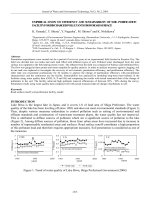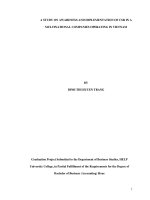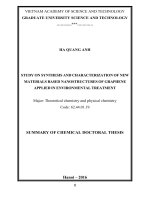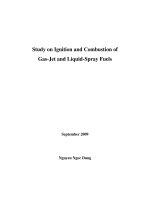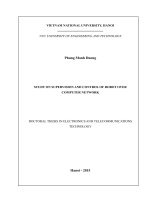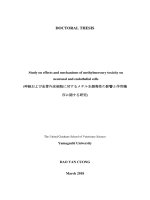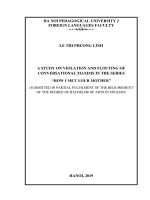Study on identification and biology of okra mites sp.
Bạn đang xem bản rút gọn của tài liệu. Xem và tải ngay bản đầy đủ của tài liệu tại đây (362.94 KB, 9 trang )
Int.J.Curr.Microbiol.App.Sci (2017) 6(3): 2538-2546
International Journal of Current Microbiology and Applied Sciences
ISSN: 2319-7706 Volume 6 Number 3 (2017) pp. 2538-2546
Journal homepage:
Original Research Article
/>
Study on Identification and Biology of Okra Mites sp.
Y.T. Jadhav1*, B.B. Bhosale2 and D.P. Barkade3
1
Department of Agricultural Entomology, Ratnai Agriculture College,
Akluj -413101(M.S.), India
2
Directorate of Extension Education, Vasantrao Naik Marathwada Krishi Vidyapeeth,
Parbhani - 431 402 (M.S.), India
3
Department of Agricultural Entomology, Ratnai Agriculture College,
Akluj -413101(M.S.), India
*Corresponding author
ABSTRACT
Keywords
Identification,
Biology, Sexually,
Parthenogenetically,
Oviposition.
Article Info
Accepted:
20 February 2017
Available Online:
10 March 2017
The present laboratory study was undertaken regarding identification and biology of okra
mites spps. at laboratory of Department of Agricultural Entomology, VNMKV, Parbhani
and some critical aspects were been studied under the supervision of Co-ordinator,
AINPAA at GKVK, Bangalore during summer 2014. The morphological characteristic
studied showed that the mite spps. identified was Tetranychus macfarlanei Baker and
Pritchard. The results of the investigations of biology of T. macfarlanei on okra were
studied by maintaining the laboratory temperatures (32 0C) and relative humidity (85 ± 3%)
which showed that the total duration from egg to adult emergence was less in male (10.03
± 0.55 days) as compared to female (11.22 ± 0.69 days). It was observed that adults of
mite spps. T. macfarlanei reproduced sexually and parthenogenetically. Sexually mated
females produced both sexes with male to female ratio of 1: 9.6 whereas, unmated females
produced only 100 per cent males. During the total oviposition period, mated female laid
near about 49.27 ± 6.38 eggs while unmated female laid 22.16 ± 7.14 eggs. The total life
cycle from egg stage till death of mite showed that the males completed life cycle earlier
within 27.00 ± 0.81 days while females required 30.61 ± 0.82 days.
Introduction
Okra (Abelmoschus esculentus (L.) Moench)
commonly known as “Lady’s finger” or
“Bhendi” is a flowering plant under
Malvaceae family having multipurpose crop
value which produces high valued edible
green pods with good nutritional value and
originated from Africa. It is mostly used as a
fresh vegetable, also consumed as canned,
dehydrated or frozen forms or in culinary
preparations, ripe seeds are roasted and used
as substitute for coffee, fruits have high
medicinal value and are used for catarrhal
attacks, fever and irritable stales of
genitourinary organs, chronic dysentery and
bland mucilage generally in form of soap
(Basu and Ghosh, 1943).
India ranks first in okra cultivation and
production with an area of 532.64 thousand
hectares and production of 6346.40 thousand
tonnes along with productivity of 13.14 mt/ha
(Anonymous, 2013). Okra is also known as
2538
Int.J.Curr.Microbiol.App.Sci (2017) 6(3): 2538-2546
the house of pests due to its two distinct i.e
vegetative and fruiting growing stages. As
high as 72 species of insects have been
recorded on okra. Besides insect pests, several
species of mites belonging to the genus
Tetranychus causes a loss of 7 to 48% in okra
fruit yield (Srinivasa and Sugeetha, 1999;
Kumaran et al., 2007). The two spotted spider
mite, Tetranychus urticae Koch was reported
as one of the important mite pests of
vegetable crops and ornamentals in
greenhouses and of several other agricultural
outdoor crops (Mondel and Ara, 2006), hence
demanding a suitable control measure owing
to its wide distribution all over the world on
different plant hosts.
The spider mite, Tetranychus cinnabarinus
(Biosduval) has assumed the status of major
pest and caused 17.46 per cent yield loss in
okra (Sarkar et al., 1996). In view of the
above facts and scarcity of related
information against Tetranychid mites on
summer okra, the present investigation were
undertaken in laboratory with an objective to
identify and study in detail biology of mites
(Tetranychus spp.) on okra.
Materials and Methods
The laboratory study was conducted in the
laboratory of Department of Agricultural
Entomology, VNMKV, Parbhani during
summer 2014. Also some critical aspects
regarding identification and biology of mites
spps. were been studied under the supervision
of Co-ordinator, AINPAA at GKVK,
Bangalore.
Maintenance of okra mite culture for
taxanomic identification and knowing
biology of mites (Tetranychus spp.)
Taxanomic identification of okra mites
(Tetranychus spp.)
sp., large number of infested leaves with
mites were collected within small plastic bags
knotted with rubber band from the okra
variety (Parbhani Kranti) experimental plot
conducted at Department of Agricultural
Entomology, VNMKV, Parbhani.
The specimen collected in small plastic bags
were stored in thermocol box to maintain the
inner temperature and secure the specimen
from any damage as it required more than 32
hours to reach AINPAA, GKVK, Bangalore
where further process regarding taxonomic
identification was carried out. Also the
purpose of collecting the mite sp. infested
leaves was to know if any natural predators or
parasitoids are present on the sample leaves
which may help for future studies.
Biology of okra mite sps.
For this laboratory experiment, infested
leaves of okra Parbhani Kranti variety by
mites sps. were collected from the field and
maintained for colonization in a plastic tray
(30 x 25 x 6 cm) placed with well moistened
synthetic absorbent sponge on which okra
leaves were kept in upper surface down
position for proper development and laying of
eggs and colonizing within 10-15 days . The
leaves were changed if turned yellow or dried
periodically.
In another plastic trays (30 x 25 x 6 cm) 20
petric plates in proportion of 5 petric plates
each tray were taken on which 4 cm x 4 cm
size okra leaf bits were kept below which well
moistened synthetic absorbent sponge
covered by single layer of blotting paper
placed for keeping okra leaf bits fresh and
turgid for longer time.
Keen observations using high frequency
electric binocular microscope were worked
out and studied regarding critical changes
been carried out during their life cycle stages.
To know the taxonomic identification of mite
2539
Int.J.Curr.Microbiol.App.Sci (2017) 6(3): 2538-2546
Results and Discussion
Egg
Taxanomic identification of okra mites
(Tetranychus spp.)
Female laid eggs (Plate 3) on the lower
surface of leaves alongwith webbings which
were smooth, translucent white, spherical in
shape just like a tiny drop of water. As the
eggs moved towards maturity they gradually
turned more brownish to creamy pinkish
colour prior to hatching showing transparent
and red eye spots at periphery area which
corresponds to simple eyes of larvae. The
period of incubation ranged between 3.58 ±
0.31 days. The matured eggs were split
vertically on one side of the cohesion from
where larva emerged by pushing it apart with
its legs leaving the egg shell intact on the leaf
surface. The hatching percentage ranged from
86 to 94 per cent (Table 1).
For knowing taxonomical identification of
mite spps., from the collected specimen
initially under electric binocular microscope
some selected mite specimen were picked on
tiny hair brush point and placed in center of
glass slide containing a drop of glycerol in
such a way that all morphological characters
necessary for identification can be clearly
seen and covered with glass slide cover slip
taking care that no air bubble was found
during preparation of the slide. These slides
were kept few days for drying and later under
the technical guidance of expertise from
AINPAA at GKVK, Bangalore a through
morphological characterization studies were
carried out which showed that the mite spps.
identified was Tetranychus macfarlanei Baker
and Pritchard (Plate 1).
Biology of T. macfarlanei Baker and
Pritchard on okra
The taxonomically identified mite spps. T.
macfarlanei on okra (Parbhani Kranti) was
studied for its biology by maintaining the
laboratory temperatures (320C) and relative
humidity (85 ± 3%). Initially reared culture
was used to obtain eggs of uniform age for
which 50 males and 50 females were selected
and released on cotton wades in petric plates
and left for 6 hours. Later on male and female
mites were removed leaving only fresh laid
eggs which were assumed to be of similar
age. The fresh laid eggs were placed
individually on 4cm x 4cm size okra leaf bit
in petric plate making 20 different
replications.
Frequent
and
regular
observations were been taken after every 3-6
hours to study detailed developmental periods
of different stages which are presented as
below (Table 1 and Plate 2).
Larva
The newly hatched larva (Plate 3) was
hexapodous having somewhat spherical or
slightly oval shape showing two prominent
red simple eyes on the dorsal propodosomal
region. After hatching the larva crawled for
sometime and later settled at a place for
feeding on the cell sap. Initially new born
larva were creamy white which turned green
and finally to dark green after initiation of
feeding for some time with dark specks
appearing dorsolaterally. The male larval
period ranged from 1.38 ± 0.19 days and that
of female larva the period ranged from 1.69 ±
0.13 days.. In general, the larval period was
shortest for male than female (Table 1).
Nymphochrysalis (Quiescent stage I )
At last period of larval development the larva
ceased to feed and entered a quiescent stage
by webbing or anchoring itself to a leaf
surface for assuming a characteristic pose in
which the anterior 2 pairs of legs were
extending forward and kept close to each
other and posterior legs were extended
2540
Int.J.Curr.Microbiol.App.Sci (2017) 6(3): 2538-2546
backwards and held close to the sides of
opisthosoma. In case of male this quiescent
stage lasted for 0.34 ± 0.11 days while in
female it lasted for 0.44 ± 0.17 days,
respectively (Table 1).
Protonymph
The newly emerged protonymph (Plate 4) was
oval shaped and slightly bigger in size than
the larva. It was easily distinguished due to
the presence of four pairs of legs and gaining
umber colour as feeding progressed with
increase in size of dark specks on the dorsum
as the time passed.
The protonymphal period of male occupied
1.59 ± 0.32 days and that of female occupied
1.79 ± 0.42 days, respectively (Table 1).
Teleiochrysalis (Quiescent stage III)
Teleiochrysalis known to be a matured
deutonymph stage enters into a third
quiescent stage (Plate 3) in which the body
was shrunken and decreased in size having
light
carmine
colour.
The
average
teleiochrysalis period of male and female was
0.61 ± 0.16 and 0.92 ± 0.23 days, respectively
(Table1).
Total developmental period
It was a duration from egg till emergence of
an adult stage which was less in case of male
(10.03 ± 0.55 days) as compared to female
(11.22 ± 0.69 days) respectively (Table 1).
Adult
Deutochrysalis (Quiescent stage II)
A matured protonymph like larva moved
towards second quiescent stage known as
deutochrysalis (Plate 3) in which all activities
of feeding were stopped and remained
anchored to the leaf surface due to that body
shrunk and decreased in size.
Deutochrysalis stages in male ranged from
0.56 ± 0.20 days and that of female the period
of stage ranged from 0.59 ± 0.22 days,
respectively (Table 1).
Deutonymph
The newly emerged deutonymph were
caramine red in colour having larger and
broder body size than the protonymph with
quite noticeable sex determination period.
The male deutonymph (Plate 3) was smaller
in size and elongated with a growth period
ranging from 0.97 ± 0.26 days whereas, the
female deutonymph was broader and larger in
size having a growth period ranging from1.21
± 0.21 days, respectively (Table 1).
The skin at later stage of teleiochrysalis was
splitting dorsally from which adults emerged
and started their activities immediately
showing pronouned sexual dimorphism
stages.
Male
The males (Plate 3) showed narrow body
having two red spots corresponding to the
simple eyes with reddish green body colour
when newly emerged turning to pinkish as
they get matured and distinctly pointed
abdomen but were still smaller than the
female. The first pair of legs was longer than
the fourth pair while the second and third
pairs were of similar size which helped for
wondering or waiting over the quiescent
female deutonymph i.e. teleiochrysalis stage.
The male on an average lived for 16.97 ± 0.26
days (Table 1).
Female
The females (Plate 3) soon after emergence
2541
Int.J.Curr.Microbiol.App.Sci (2017) 6(3): 2538-2546
showed reddish bright colour which after
feeding changed to carmine/ brick red with
two red spots like simple eyes on the sides of
dorsal propodosomal region. The female was
found bigger than the male with a rounded
and oval shaped abdomen and on an average
lived for 19.39 ± 0.13 days (Table 1).
Mating
As males emerged little earlier than females
they wandered on the leaf surface in search of
a quiescent female deutonymph and when
found, it placed the anterior pair of legs on
female and waited for its emergence. There
was an aggressive fighting been seen
sometimes among three or four males
themselves near the female by extending their
chelicerae and pricking the other individuals.
Also males were found helping the adult
female to emerge out by pulling out the
ecdysial skin of female by its two anterior
pair of legs. When succeeded the male
immediately slide underneath the female with
its hysterosoma upturned, while the female
raised its posterior abdominal region to
accommodate the male for mating(Plate 3)
and holding the female with front two pairs of
legs during the process of coupling which
lasted for about one to three minutes. Single
male was observed to mate with several
females, but a female usually mated only once
soon after emergence. While older females
were occasionally preferred by males for
mating purpose.
Table.1 Biology of Tetranychus macfarlanei on okra at temperature 32ºC and
under laboratory conditions
Growth Stage
Sex
Egg
Larva
Male
Female
Male
Female
Male
Female
Male
Female
Male
Female
Male
Female
Male
Female
Nymphochrysalis
Protonymph
Deutochrysalis
Deutonymph
Teleiochrysails
Total
Developmental
period
2542
Developmental
period in days
(Mean ± SD)
3.58±0.31
1.38±0.19
1.69±0.13
0.34±0.11
0.44±0.17
1.59±0.32
1.79±0.42
0.56±0.20
0.59±0.22
0.97±0.26
1.21±0.21
0.61±0.16
0.92±0.23
10.03±0.55
11.22±0.69
85 ± 3% RH
Int.J.Curr.Microbiol.App.Sci (2017) 6(3): 2538-2546
Table.2 Life history parameters of adults of Tetranychus macfarlanei on okra at temperature 32º
C and 85 ± 3% RH under laboratory conditions
Period
Pre oviposition
Oviposition
Post oviposition
Adult longevity
Fecundity
Male: Female
Ratio
No of eggs
laid/day/ female
Total life cycle
Sex
Mated female
Unmated female
Mated female
Unmated female
Mated female
Unmated female
Male
Female
Mated female
Unmated female
Mated female
Unmated female
Mated female
Unmated female
Male
Female
Duration in Days
(Mean ± SD)
1.59 ± 0.28
1.14 ± 0.36
15.83 ± 0.16
17.92 ± 0.82
1.63 ± 0.14
1.96 ± 0.62
16.97 ± 0.26
19.39 ± 0.13
49.27 ± 6.38
22.16 ± 7.14
1:9.6
1:0
2.95 ± 0.67
1.12 ± 0.52
27.00 ±0 .81
30.61 ± 0.82
Plate.1 Supportive morphological characters for identification of Tetranychus macfarlanei Baker
and Pritchard mite spps
2543
Int.J.Curr.Microbiol.App.Sci (2017) 6(3): 2538-2546
Plate.2 Maintenance of okra mite culture for taxanomic identification and knowing biology of
mites (Tetranychus spp.)
Plate.3 Life cycle of Tetranychus macfarlanei Baker and Pritchard mite spps
2544
Int.J.Curr.Microbiol.App.Sci (2017) 6(3): 2538-2546
30.61±0.82 days to complete its life cycle (Table
2).
Sex ratio
It was observed that adults of mite spps. T.
macfarlanei
reproduced
sexually
and
parthenogenetically. Sexually mated females
produced both sexes with male to female ratio of
1: 9.6 whereas, unmated females produced only
100 per cent males.
Pre oviposition period
The mated and unmated female laid eggs only
after a lapse of certain period which lasted for
1.59 ± 0.28 days in case mated female while it
lasted for 1.14 ± 0.36 days in case of unmated
females. As the females fertilized immediately
after emergence the pre copulation period was
very negligible in case of mated females (Table
2).
Oviposition period
The egg laying period of mated and unmated
females lasted for somewhat longer period if been
compared with its total developmental period. In
case of mated females it took 15.83 ± 0.16 days
for laying eggs whereas unmated females required
a little longer time i.e., 17.92 ± 0.82 days
respectively (Table 2).
Fecundity
During the total oviposition period, the mated
female laid near about 49.27 ± 6.38 eggs while
unmated female laid 22.16 ± 7.14 eggs. The daily
egg production by mated female was nearby 2.95
± 0.67 eggs whereas unmated female was 1.12 ±
0.52 eggs respectively (Table 2).
Post oviposition period
Post oviposition period in mated females lasted
for 1.63 ± 0.14 days and for unmated females it
lasted for 1.96 ± 0.62 days ( Table 2).
Total life cycle
From the above studies regarding the life cycle of
mite spps. T. macfarlanei it was observed that
total life cycle from egg stage till death of mite
showed that the males completed life cycle earlier
within 27.00±0.81 days while females required
These results are in line with the works of Sharma
(2010) and Kumar and Raghuraman (2013) who
reported its biology on brinjal, whereas Thulsiram
(1991) and Bhanderi (1991) recorded varying
developmental periods which differed from
present study may probably be due to change in
species studied, hosts on which it was reared and
climatic condition.
The female longevity lasted for about 19.39 days
while, the male lived for a period of 16.97 days.
The males emerged earlier and were found
waiting near the female quiescent deutonymph.
Both parthenogenetic and sexual type of
reproduction was seen. Longer time was taken by
unmated females to complete their pre
oviposition, oviposition and post oviposition
period as compared to mated females which was
found somewhat similar to the findings of Patil
(2005) and Shaw and Devroy (1995) while
differed with the studies of Sejalia et al. (1993). In
the present study the mated females laid more
eggs than unmated ones, the results being which is
in accordance with that of Singh et al (1996).
The total egg production by T. macfarlanei was
49.27 in mated females while unmated females
laid 22.16 eggs. The results are comparable with
the findings of Kumar and Raghuraman (2013)
but differed with Rai et al (1995) and Singh et al.
(1996). The higher fecundity of T. macfarlanei
has been reported by Jose and Shah (1989), who
observed 137 eggs per female on cotton. The male
to female ratio observed was (1:9.6) contradictory
with the studies of Singh et al. (1996). The per
cent viability of eggs (86-94%) was similar to that
observed by Patil (2005) and Jose and Shah
(1989).
In conclusion, as mites now a days are assuming a
serious pest status due to their phytophagous
nature, high reproductive potential and short life
cycle which contributes for rapid resistance
development to many acaricides often after a few
applications (Cranham and Helle, 1985; Devine et
al., 2001; Stumpf and Nauen, 2001). Hence to
overcome this a new dimensional study was been
undertaken to identify the spps. and work out
2545
Int.J.Curr.Microbiol.App.Sci (2017) 6(3): 2538-2546
biology of okra mites (Tetranychus spp.) which
may surely help for their effective management.
References
Anonymous, 2013. Indian Horticultural Database
2013-14. National Horticultural Board,
Ministry of Agriculture, Government of
India.
Basu, K.H. and Ghosh, B.D.1943. Nutritional
Status in Some Vegetables. Indian J.
Medicinal Res., 31: 29-31.
Bhanderi, G. R. 1991. An Ecology of Tetranychus
macfarlanei Baker and Pritchard (Acari :
Tetranychidae) in Relation to Different
Okra Cultivars and its Control.
M.Sc.(Agri) Thesis, Gujarath Agricultural
University, Navasari.
Jose, V. T. and Shah, A. H. 1989. Binomics of the
Spider Mite, Tetranychus macfarlanei
Injurious to Cotton in Gujarat, India. In:
Progress
in
Acarology),
Eds.,
Channabasavanna G. P. and Viraktamath,
C. A., Oxford and IBH Publishing Co.Pvt.
Ltd., New Delhi.
Kumar, D. and Raghuraman, M. 2013. Biology of
Carmine Mite, (Tetranychus urticae koch)
on Brinjal Leaf. Bioinfolet., 10(4C): 14201423.
Kumaran, N., Douressamy, S. and Ramaraju, K.
2007. Bioefficacy of Botanicals to Two
Spotted Spider Mite, Tetranychus urticae
(Acari: Tetranychidae) Infesting Okra
(Abelmoschus esculentus L.). Pestology.,
31(9): 43-49.
Mondel, M. and N. Ara. 2006. Biology and
Fecundity of the Two Spotted Spider
Mite, Tetranychus urticae Koch. (Acari:
Tetranychidae)
Under
Laboratory
Conditions. J. Life Earth Sci., 1: 43-47.
Patil, R. S. 2005. Investigations on Mite Pests of
Solanaceous Vegetable with Special
Reference to Brinjal. P.hd. (Agri.) Thesis,
University of Agricultural Sciences,
Dharwad.
Rai, A. B., Sejalia, A. S., Patel, C. B. and Kumar,
S. 1995. The Rate of Natural Increase of
Red Spider Mite when Reared on Okra.
Gujarat Agril. Uni. Res. J., 21(1): 130136.
Sarkar, P.K., Mukherjee, A.B. and Ghosh, J.
1996. Assessment of Loss of Bhendi
Against Red Spider Mite. Env. Eco.,
14(2): 480-481.
Sejalia, A. S., Rai, A. B., Patel, C. B. and
Radadai, G. G. 1993. On the Biological
Aspects of Tetranychus macfarlanei
(Acari : Tetranychidae) Infesting Okra
(Abelmoschus esculentus) in South
Gujarat. GAU Res. J., 19: 32-37.
Sharma, A. S. R. 2010. Seasonal Incidence and
Management of Brinjal Mite, Tetranychus
spp. P.hd. (Agri.) Thesis, University of
Agricultural Sciences, Dharwad.
Shaw, K. K. and Devroy, T. C. 1995. Biology of
Vegetable Red Spider Mite, Tetranychus
neocaledonicus
Andre (Acarina :
Tetranychidae) on Brinjal. J. Agril. Sci.
Soc. North East India., 8: 6-9.
Singh Rishi Kumar, S. K. Malik and Naveen
Aggarwal V. S. 1996. Biological Studies
of Red Spider Mite, Tetranychus
cinnabarinus (Boisduval) on Okra. Ann.
Agril. Res., 17(1): 60-63.
Srinivasa, N. and Sugeetha, G. 1999. Bioeffectiveness of Certain Botanical and
Synthetic Pesticides Against Okra Spider
Mite Tetranychus macfarlaeni. J. Acarol.,
15(1&2): 1-5.
Thulsiram. 1991. Binomics and Chemical Control
of Tetranychus macfarlanei on Cotton.
M.Sc. (Agri.) Thesis, University of
Agricultural
Sciences,
Dharwad.
How to cite this article:
Jadhav, Y.T., B.B. Bhosale and Barkade, D.P. 2017. Study on Identification and Biology of Okra Mites
sp. Int.J.Curr.Microbiol.App.Sci. 6(3): 2538-2546. doi: />
2546
